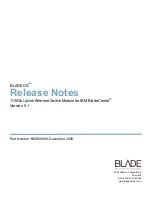
BLADE OS 5.1 Release Notes
BMD00098, December 2009
13
Hot Links
BLADEOS 5.1 now supports Hot Links. Hot Links provides basic link redundancy with fast
recovery for network topologies that require Spanning Tree to be turned off.
Hot Links allows up to five triggers, each of which consists of a pair of layer 2 interfaces that may
contain either an individual port or trunk. One interface is the Master, and the other is a Backup.
While the Master interface is active and forwarding traffic, the Backup interface is placed in a
standby state and blocks traffic. If the Master interface fails, the Backup interface becomes active
and forwards traffic. Once the Master interface is restored, it transitions to the standby state and
blocks traffic unless the Backup interface fails.
OSPF Enhancements
BLADEOS 5.1 includes multiple enhancements to the GbESM Open Shortest Path First (OSPF)
implementation:
Passive Interfaces
OSPF interfaces may be configured as
passive
. Passive interfaces send LSAs to active
interfaces, but do not receive LSAs, hello packets, or any other OSPF protocol information
from active interfaces. Passive interfaces behave as stub networks, allowing OSPF routing
devices to be aware of devices that do otherwise participate in OSPF (either because they do
not support it, or because the administrator chooses to restrict OSPF traffic exchange or
transit). The following command has been added:
Point-to-Point Networks
For LANs that have only two OSPF routing agents (the GbESM and one other device),
specifying the interfaces as part of a point-to-point network allows the switch to significantly
reduce the amount of routing information it must carry and manage, enhancing OSPF
efficiency. The following command has been added:
Sub-second timers
To increase OSPF convergence speed,
hello
and
dead
timers for OSPF interfaces and virtual
interfaces can now specified in milliseconds by adding “ms” to the number. For example:
Loopback Interface Address
OSPF can now be configured to use the GbESM internal loopback address in advertising its
Router ID.
# /cfg/l3/ospf/if
<x>
/passive {enable|disable}
# /cfg/l3/ospf/if
<x>
/ptop {enable|disable}
# /cfg/l3/ospf/if
<x>
/hello 200ms
(200 milliseconds)


























